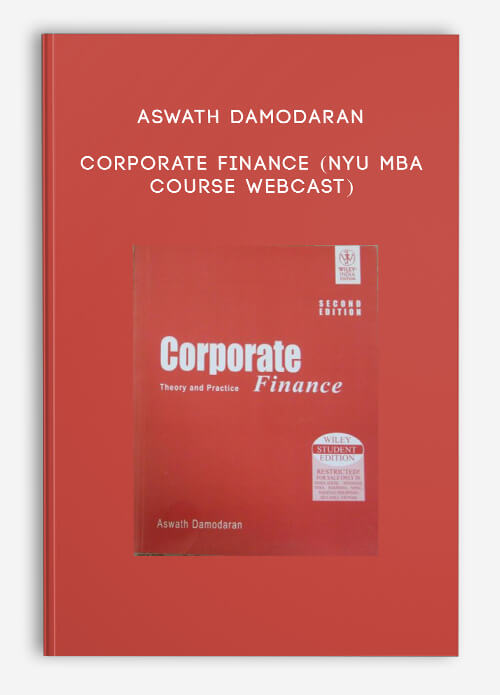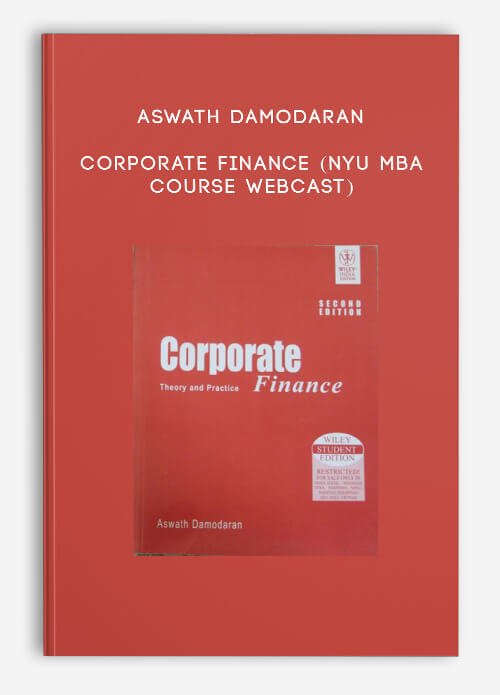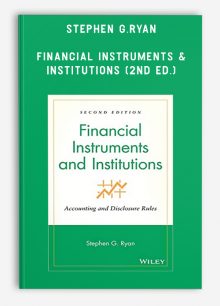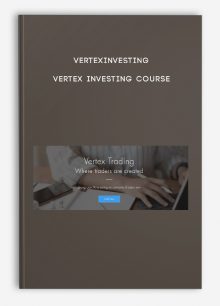Aswath Damodaran – Corporate Finance (NYU MBA Course WEBCAST)
$144.90 $47.00
Product Include:
File size:
Aswath Damodaran – Corporate Finance (NYU MBA Course WEBCAST)
**More information:
Get Aswath Damodaran – Corporate Finance (NYU MBA Course WEBCAST) at Salaedu.com
Description
What is corporate finance?
Every decision that a business makes has financial implications, and any decision which affects the finances of a business is a corporate finance decision.
Defined broadly, everything that a business does fits under the rubric of corporate finance.
Course objectives
To give you the capacity to understand the theory and apply, in real world situations, the techniques that have been developed in corporate finance.
Motto for class: If it cannot be applied, who cares?.
To give you the big picture of corporate finance so that you can understand how things fit together.
Motto for class: You can forget the details, but doní’ miss the story.
To show you that corporate finance is fun.
Motto for class: Are we having fun yet?
Lecture 1:
This is corporate finance!
Overview of class
Lecture 2:
The objective in Corporate Finance
Maximize value, stockholder wealth and stock price
Making the world safe for stock price maximization
What can go wrong?
Acquisitions and corporate governance
The Bondholder-stockholder conflict
Markets and Information
Social costs
Lecture 3:
Acquisitions and corporate governance
The Bondholder-stockholder conflict
Markets and Information
Social costs
Lecture 4:
Market prices fail: What’s next?
– Alternative corporate governance systems
– A different objective
– Stock price maximization with limits
The right objective
Defining risk
Lecture 5:
Firm Specific and Market Risk
The “marginal investor”
To the CAPM and beyond..
Inputs to the CAPM: The riskfree rate
Lecture 6:
Sovereign Default Spreads: What, why and how?
Equity Risk Premium
– Determinants
– Estimation Approaches
Lecture 7:
Picking an equity risk premium
Beta
– The standard regression
– Jensen’s alpha
– R squared
Lecture 8:
More thoughts on regression betas
Determinants of betas
– Discretionary products & services
– Fixed cost structure
– Financial leverage
Lecture 9:
Bottom up Betas
– Rationale
– Process for estimating bottom up betas
Lecture 10:
Betas and costs of equity for private businesses
Lecture 11:
Definiing debt
The cost of debt
Leases as debt
Weights for cost of capital
Lecture 12:
The Investment Principle
– Time weighted, incremental cash flow returns
– What is a project?
– Axccounting returns
Lecture 13:
From earnings to cash flows
– The effect of depreciation
– Maintaenance cap ex
– Working capital
From cash flow ot incremental cash flow
– Sunk costs
– Allocated expemses
From incremental to time weighted cash flows
– NPV versus IRR
Lecture 14:
Monte Carlo Simulations
Equity Analysis
– ROE
– Cash flows to equity and NPV
Valuing an acquistion target
NPV vs IRR
Lecture 15:
NPV vs IRR: Reinvestment assumptions
Side costs and benefits
– Opportunitiy costs
– Cost of excess capacity
Lecture 16:
Discussion of Apple iTV case
Synergies in projects
Options in projects
Analyzing an existing project
Lecture 17:
The Financing Decisions
– What is debt?
– The Life Cycle view of Financing
– The trade off on debt: Pluses and Minuses
– The Miller Modigliani Theorem
Lecture 18:
The financing heirarchy
The cost of capital approach to optimizing debt ratios
Lecture 19:
More on the cost of capital approach
The follow up to the optimal
– Why?
– What if something goes wrong?
– What if you invest, instead of buying back stock
The enhanced cost of captial approach
Lecture 20:
Determinants of optimal debt ratio: Cost of capital approach
APV approach
Relative Analysis
Actual vs Optimal: Follow up steps
Lecture 21:
The right debt for your firm
Approaches to finding the right debt
– Intuitive Analysis
– Project financing
– Macroeconomic regressions
Lecture 22:
The Dividend Principle
– Descriptive facts
– Three schools of though on dividends
Lecture 23:
Three good reasons for paying dividends
A framework for assessing dividend policy
Lecture 24:
Dividends and FCFE
How much cash is too much cash?
A framework for assessing dividend policy
First steps in valuation
Lecture 25:
Inputs to DCF valuation
– Cash flows
– Discount rates
– Growth rates
– Terminal value
Lecture 26:
The Grand Finale
– A final review
– Wrapping it all up (to go)
Financial Development Course
Financial development means some improvements in producing information about possible investments and allocating capital, monitoring firms and exerting corporate governance, trading, diversification, and management of risk, mobilization and pooling of savings, easing the exchange of goods and services.
1 review for Aswath Damodaran – Corporate Finance (NYU MBA Course WEBCAST)
Add a review Cancel reply
Related products
Financial Development Course
Stephen G.Ryan – Financial Instruments & Institutions (2nd Ed.)
Financial Development Course
Financial Development Course
Financial Development Course
Financial Development Course
Financial Development Course
Financial Development Course











king –
We encourage you to check Content Proof carefully before paying.“Excepted” these contents: “Online coaching, Software, Facebook group, Skype and Email support from Author.”If you have enough money and feel good. We encourage you to buy this product from the original Author to get full other “Excepted” contents from them.Thank you!